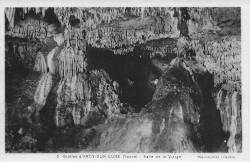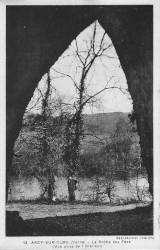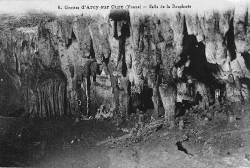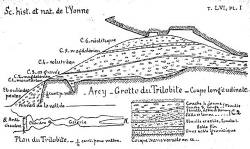Grottes d’Arcy-sur-Cure
Caves of Arcy-sur-Cure - Grotte du Renne
Useful Information



| Location: |
Near Arcy-sur-Cure.
Motorway A6, exit Auxerre-sud, Nitry, or Avallon.
At R.N.6 between Auxerre and Avallon, 800 m south of Arcy.
(47.591459, 3.767010) |
| Open: |
APR to NOV daily 10-18. Online booking or reservation by phone or email required. [2021] |
| Fee: |
Adults EUR 9.50, Young Adults (16-25) EUR 8.50, Children (12-15) EUR 6.50, Children (3-11) EUR 6, Children (0-2) free, Students EUR 8.50, Disabled EUR 8.50. Groups (20+): discount 15%. [2021] |
| Classification: |
 Karst Cave Karst Cave
 Painted Cave Painted Cave
|
| Light: |
 Electric Light Electric Light
|
| Dimension: | L=900 m, T=12 °C. |
| Guided tours: |
Discovery tour: D=75 min. Prehistorical tour: D=100 min. Archaeological tour: D=3 h. V=180,000/a [2000] |
| Photography: | not allowed |
| Accessibility: | yes |
| Bibliography: |
Dominique Baffier, Michel Girard (1998):
Les cavernes d’Arcy-sur-Cure,
Avant-propos de Gabriel de La Varende,
Paris, La Maison des Roches, 1998, 120 p., ISBN 2-912691-02-8.
 google books
google books
Tim Appenzeller (1998): ART: Evolution or Revolution? Science 20 November 1998, Vol. 282, Issue 5393, pp. 1451 online DOI |
| Address: |
Grottes d’Arcy-sur-Cure, Manoir du Chastenay, 38 Grande Rue, Val Sainte Marie, 89270 Arcy-sur-Cure, Tel: +33-386-819063, Tel: +33-671-981833.
E-mail: |
| As far as we know this information was accurate when it was published (see years in brackets), but may have changed since then. Please check rates and details directly with the companies in question if you need more recent info. |
|
History
| 1666 | first written mention of Grotte des Fées and Grande Grotte by Jacques de Clugny. |
| 1763 | Grotte des Fées and Grande Grotte visited, described and drawn up by geographer François Pasumot. |
| 1853 | Bones and flints discovered in the Grotte des Fées, Robineau-Desvoidy and the owner of the caves make first excavation. |
| 1859 | Neanderthal remains found in Grotte des Fées by the Marquis de Vibraye, which made the site famous. |
| 1886 | Grotte du Trilobite discovered by Dr. A. Ficatier from Auxerre and named after a trilobite he found in the cave. |
| 1889 | Abbé Parat discovers a cave he calls le trou de la Hyène, today called Grotte de l’Hyène. |
| 1895-1898 | Grotte du Trilobite excavated by Abbé Parat in three consecutive winters. |
| 1939 | Grotte du Renne discovered by Pierre Poulain. |
| 1947 | beginning of excavations by the French prehistorians Arlette and André Leroi-Gourhan. |
| 1948 | Grotte de l’Hyène excavated. |
| 1956-1961 | Grotte du Renne excavated. |
| 1962 | Abri du Lagopède discovered and excavated by Arlette and André Leroi-Gourhan. |
| 1963 | end of excavations. |
| 01-MAY-1964 | Groupe Spéléologique et Préhistorique Parat (G.S.P.P.) proofs the connection between the Grotte des Fées and Grotte de Barbe-Bleue with dye tracing. |
| 1966-1970 | Groupe Spéléologique Yonne-Vercors makes Grotte des Fées the longest known cave of Yonne. |
| 1990 | additional Palaeolithic cave paintings discovered. |
| 1992 | listed as a monument historique (Historic Monument) |
| 1993 | Hallstattian drum fibula excavated in Grotte des Fées. |
| NOV-2000 | Arnold Haid and Philippe Radet cross the limestone massif between the Grotte des Fées in the south and the resurgence of the Moulinot in the north underground. |
Description






The Grottes d’Arcy-sur-Cure are eleven small caves which were formed by the Cure river in coral reef limestone. One of the caves, La Grande Grotte (The Big Cave), the biggest one, is open to the public as a show cave. Other caves, like Grotte du Renne (Reindeer Cave) and the Grotte de l’Hyène (Hyena cave) are archaeological sites and not open to the public. The site is also known as Grotte du Renne, because this is the most important of the caves. The caves are located on the left bank of the river Cure. The river has formed huge meanders with high cliffs on the outside, up to 125 m high. The cliff with the caves is a white limestone cliff which faces more or less southwards, which is important. The caves were used as shelter, and during the last cold age it was colder than today. A shelter was much more comfortable when the sun was shining in.
On a section of 800 m length along the river the caves can be found at various heights. The number of caves given varies from publication to publication. Some say there are 11 caves, which are the bigger caves without the abris. The total number is currently 16, which includes the abris. We do not have the length for any cave, but at least for the most important. The distance given in front of the cave names is the distance from the Grande Grotte upstream. Here is the list of the 16 caves.
- 0 m Grande Grotte (Great Cave)
- 200 m Abri du Lagopède (Ptarmigan Shelter), A=145 m asl.
- 235 m Grotte du Cheval (Horse cave), L=60 m.
- 250 m Grotte de l’Hyène (Hyena cave), A=125 m asl,
- 260 m Grotte du Trilobite (Trilobite Cave), L=126 m, A=130 m asl.
- 270 m Grotte de l’Ours (Bear Cave)
- 280 m Grotte du Renne (Reindeer Cave)
- 280 m Galerie de Schoepflin (Schoepflin Gallery)
- 290 m Grotte du Bison (Bison Cave), L=20 m, A=130 m asl.
- 300 m Grotte du Loup (Wolf Cave)
- 310 m Grotte du Lion (Lion Cave)
- 360 m Grotte des Deux Cours (Two Flows Cave)
- 380 m Grotte des Fées (Fairies Cave), L=2,820 m, A=130 m asl.
- Petit Abri (Small Shelter)
- Grand Abri (Large Shelter)
- 700 m Grotte des Goulettes (Goulettes Cave)
The caves were used as a shelter by stone age man and contained numerous artifacts. There are animal and human remains, bones, shards, flint tools and teeth. The caves became famous after the Marquis de Vibraye declared some remains found in the Grotte des Fées as Neanderthal remains. That the caves contain massive Neanderthal remains is undisputed, but they are still the topic of a dispute by the experts. An array of grooved teeth and other ornaments is interpreted as the handiwork of Neanderthals. During the 1950s and 1960s dozens of pierced and grooved animal teeth for use as ornaments were excavated. Other finds were a handful of ivory beads and pendants and circular huts supported by mammoth tusks. No other Neanderthal site has produced anything similar to this treasure of symbolic objects. The age is still unclear, generally around 35,000 years are assumed. However, other theories of an age of 45,000 years are still not disproved, and this would mean the artifacts were created before modern humans arrived. The core of this dispute is the question, if non-modern humans like the Neanderthals were able to create art and ornament.p
Undisputed it the fact, that the Neanderthals used the caves since the Lower Palaeolithic (200,000 BP) and during the Middle Palaeolithic, Mousterian and Châtelperronian. Modern humans used the caves during Aurignacian, Gravettian, Proto-Solutrean and Magdalenian. This is the only known almost uninterrupted series from the Mousterian to the Gravettian in France. It is one of the most important site for the Châtelperronien. The caves were also used during the Middle Ages.
The highlight of the caves are cave paintings from the middle and late Palaeolithic period, which were discovered in 1990. A few engravings have been found in the 19th centuries, others were recorded in 1946, but the paintings were overlooked. Pierre Guilloré discovered the first paintings in April 1990 in the Grande Grotte (Great Cave). They were protected by a thin layer of flowstone, hiding them from view and protecting them from destruction. Some other paintings were destroyed by regular cleanings of the cave walls with high-pressurized water between 1976 and 1990. The walls were covered by a black soot layer, a result of a century of visits with torches or petroleum lamps.
The paintings are said to be the second oldest, according to radiocarbon dating on charcoal remains in corresponding strata they are 28,000 years old.
The oldest are those in
 Grotte Chauvet
which are 31,000 years old.
There are about 200 paintings located 300 m to 500 m from the entrance, including hand prints, bears, mammoths and ibexes.
They were painted with ochre and charcoal.
The characteristic feature of the paintings are the open feet, one leg at the front and one leg at the rear.
However, the paintings cannot compare with the famous painted caves in quality or number.
Only 160 of them have been found so far, most of them are not accessible for their protection.
Grotte Chauvet
which are 31,000 years old.
There are about 200 paintings located 300 m to 500 m from the entrance, including hand prints, bears, mammoths and ibexes.
They were painted with ochre and charcoal.
The characteristic feature of the paintings are the open feet, one leg at the front and one leg at the rear.
However, the paintings cannot compare with the famous painted caves in quality or number.
Only 160 of them have been found so far, most of them are not accessible for their protection.
The caves are privately owned by Mr. Gabriel de la Varende. Fortunately he is a huge supporter of the work of the archaeologists, he has not only allowed excavation, he actively supported the research from the beginning.
The caves are actually very closely related. They were formed by water from the river Clune, and since the river cut its bed deeper, they are the fossil level, only about 3 m to 10 m above the current river level. The caves were speleologically explored during the second half of the 20th century, and the cave system of the Grotte des Fées is the longest known cave of Yonne with a total length of 2.820 m. There is a water-filled active level right below, which was recently explored by cave divers. The cave divers Arnold Haid and Philippe Radet crossed the limestone massif between the Grotte des Fées in the south and the resurgence of the Moulinot in the north in November 2000.
In 2021 the cave offers only pre-booked tours, probably a result of Covid-19. Online booking is recommended, but you can also phone or email. As far as we understand there are no regular open hours anymore, except for the general frame of April to November with daily opening. The number of offered tours depends on the season. You will find the dates and times on the online booking system on their website.
 Member of the International Show Caves Association (ISCA)
Member of the International Show Caves Association (ISCA) Search DuckDuckGo for "Caves of Arcy-sur-Cure"
Search DuckDuckGo for "Caves of Arcy-sur-Cure" Google Earth Placemark
Google Earth Placemark Grottes d’Arcy-sur-Cure, official site (visited: 15-DEC-2020)
Grottes d’Arcy-sur-Cure, official site (visited: 15-DEC-2020) Index
Index Topics
Topics Hierarchical
Hierarchical Countries
Countries Maps
Maps